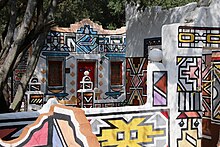Ndebele (South Africa)
The Ndebele (own name amaNdebele ; occasionally also South Ndebele ) are an ethnic group living in northern South Africa . An ethnic group in Zimbabwe is also called Ndebele .
Description and history
The approximately 1.1 million Ndebele belong to the Nguni , a group of the Bantu , as well as the Zulu , Xhosa , Swazi and others. Most of them live in what is now the South African province of Mpumalanga , to which they probably immigrated from the Natal area between the 15th and 16th centuries , and in the provinces of Gauteng and Limpopo . The Ndebele in Limpopo form their own subgroup, which is strongly influenced by the Sotho there .
The first head of the Ndebele known by name was Mafana, who lived around 1500. In the 19th century, Boers settled in the Ndebele settlement area during the Great Trek and tried to displace them. A large part of the Ndebele then fled to the Konomtjharhelo caves . The Boers first tried to blow up the caves. When this failed, they besieged the caves for nine months and starved those who had fled until only 8,000 of the 15,000 trapped in the caves were still alive. Those who were still able to work were obliged to work on the Boer farms.
1981 to 1994 most of the South African Ndebele were assigned to the homeland KwaNdebele . Since there were only a few jobs there, many of them had to drive long distances to work in Pretoria or in neighboring cities every day .
Customs and traditions

Due to the dependence on the Boers, many Ndebele lost their cultural identity. The traditional ceremonies and the joy of colors were only maintained in the groups further south. The colorful design of the houses and clothing is a characteristic of this ethnic group. Esther Mahlangu , renowned artist in South Africa, designed the first African Art Car, a BMW 525i , in the Ndebele style in 1991 .
Traditionally, the marital status of women can be recognized by their jewelry and clothing: married women wear heavy brass or copper rings ( iindzila ) around their necks, arms and legs , while the young girls adorn themselves with pearl-studded beads. The heavy metal jewelry around the neck and limbs is usually worn for life. The neck rings are individual rings that have the same meaning as wedding rings. The women get them put on for the wedding. They are a status symbol and a sign that they are married. The wealthier the man, the more rings the woman gets. The Ndebele also maintain their own musical tradition, a choral singing, the leg rattles ( amahlwayi ) and impact wood ( izikeyi is accompanied). The initiation is often carried out, called ukuwela for boys and iqhude for girls . However, many Ndebele no longer live traditionally. Most of them are Christians, but they also cultivate ancestral cult and believe in magic .
The language of the Ndebele ( Süd-Ndebele , isiNdebele or Nrebele) is mostly assigned to the Nguni languages. It contains clicks . In the way they settle, the South African Ndebele differ from the Zimbabwean Ndebele . They prefer to live in round huts, while the Zimbabwean Ndebele prefer angular houses. Patriarchal structures often occur, such as polygamous marriages, in which every woman is entitled to her own house.
The Ndebele culture is cultivated and brought to the public in the museum village of Botshabelo near Middelburg .
Web links
- Description at sahistory.org.za (English)
- Cultural heritage of the Ndebele ( Memento of October 16, 2012 in the Internet Archive )
Individual evidence
- ↑ a b c d e f g Description at sahistory.org.za (English), accessed on September 18, 2015
- ↑ Information on the Botshabelo Museum Village , accessed on September 18, 2015


